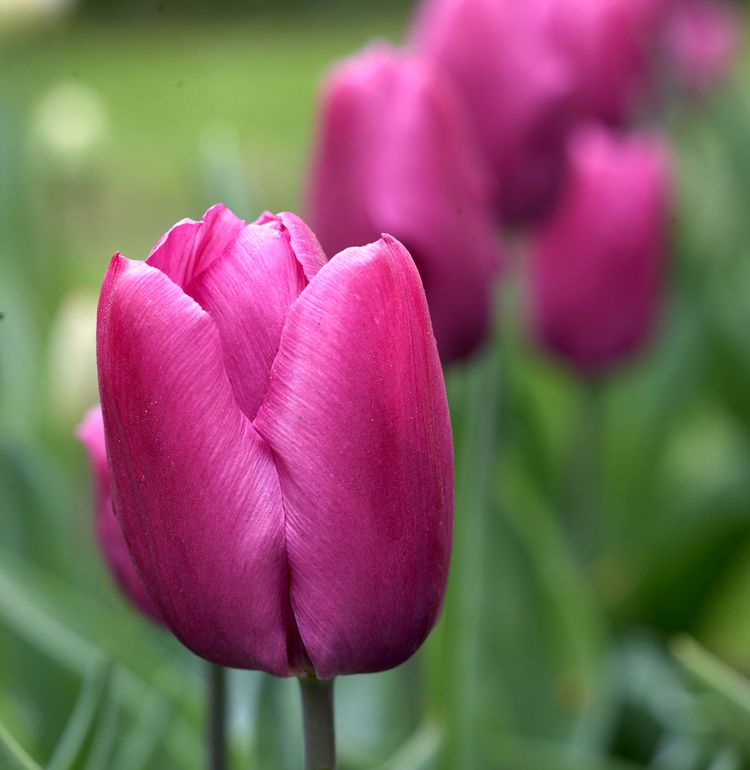Tulips announce spring with their colorful petals. Blooming from early to late spring, these bulbs usher in the season with beauty and cheer. Some types of tulips have perennial characteristics, readily appearing in spring year after year for decades. Other tulip bulbs bloom with gusto for one season and then put up a small flower or two before fading from the garden scene a couple of years later. Here's what to expect from various types of tulips, plus the best way to care for these bulbs so they last as long as possible in your garden. If you’d like to add reliably perennial tulips to your garden, you'll find tips for choosing the best of these types, too.
Are tulips perennials or annuals?
Technically, all tulips are perennials that have the ability to survive winter and grow again the following year. However, some types of tulips have been bred to unfurl the largest, showiest blooms the first spring after planting the bulbs the previous fall. These single season sensations are usually modern hybrids. Especially useful in planting beds that are transitioned to a colorful collection of summer annuals, modern hybrid tulips are often treated as annuals. The bulbs are pulled up and composted after they finish blooming. Planting new tulip bulbs in autumn will create another bold color show the following spring.
Can tulip bulbs be left in the ground year-round?
If left in the ground, modern tulip hybrids will send up a small bloom or two the next year if the growing conditions are right—tulips grow best is soil that is dry in summer, the bulbs will rot in moist soil and irrigated garden beds. By year three or four after planting, modern hybrids usually produce leaves but few, if any flowers. Well-known types of modern hybrids that bloom well for one season include single early, double early, lily flowering, triumph tulips, peony flowering, parrot, and single late tulips.
However, there are several other types of tulips that you can leave in the ground and they will come back beautifully each year. Species tulips and Greigii types, along with waterlily tulips and Darwin hybrids, are all known to come back yearly when they are planted in a site that meets their needs.
How to Get Tulips to Come Back Each Year
Bulb Planting Tips
Tulips thrive in well-drained soil so planting tulip bulbs in loose soil that never remains soggy is essential. A planting site that isn’t irrigated in summer is best for tulips. Full sun is also vital for strong tulip growth. Tulips grow best when they receive at least 8 hours of direct sunlight per day. Plant each bulb at least 8 to 10 inches deep in fall—don’t skimp on the planting depth.
Tulip Care Tips
Coax tulips to come back strong the next year by:
- Snipping off the flower after the petals fade to channel energy into the bulb where next year’s flower is developing.
- Allowing the foliage to die back naturally, removing it from the garden after it is fully yellow and withered.
- Fertilizing bulbs with a granular 5-10-5 fertilizer in fall, early spring, and late spring. The additional nutrients will help the bulb develop a more robust flower the following season.
The Best Perennial Tulip Bulbs
Tulips that bloom for years in the garden take on many different forms. Some resemble the tall, showy traditional tulips while other types hug the ground and have a more delicate appearance. Choose the best perennial tulips for your garden and enjoy their flowers year after year.
Darwin Hybrids
Long, sturdy stems and large, cup-shape flowers make Darwin hybrids some of the showiest tulips available. While there is never a guarantee that a tulip will come back the next year, Darwin hybrids have a good track record of reblooming yearly when planted deeply. Resist the urge to cut the 18- to 26-inch-tall Darwin hybrid flowers for enjoyment inside because this will negatively impact the bulb’s ability to rebloom the following year. If you would like to use tulips as cut flowers, plant a separate tulip cutting garden.
Waterlily Tulips
Colorful, low-growing tulips perfect for the front of the border or rock gardens, waterlily tulips have slightly pointed petals that curve outward. The two-tone flowers resemble stars when they are fully open. Also called Kaufmanniana tulips, these flowers stand 8 to 10 inches tall and bloom in shades of white, pink, and red. Some selections have mottled foliage.
Greigii
Greigii tulips are known for their mottled foliage. Their bluish-green leaves are commonly striped or spotted with shades of burgundy. The unusual, patterned foliage is the perfect complement to their bright, clear-colored flowers. Some Greigii varieties stand just 8 inches tall in full bloom while others grow to 20 inches tall.
Species Tulips
The most reliable perennial tulips, species tulips will naturalize, or spread, over time to create drifts of color. Their small, elegant flowers are available in a rainbow of colors. Varieties of Tulipa clusiana are some of the most common species tulips. Their thin, delicate foliage is grass-like, which helps them blend into a lawn with ease. Plant species tulips about 6 inches apart so they have plenty of space to create new bulblets. These tulips grow 3 to 15 inches tall, depending on the variety.




















